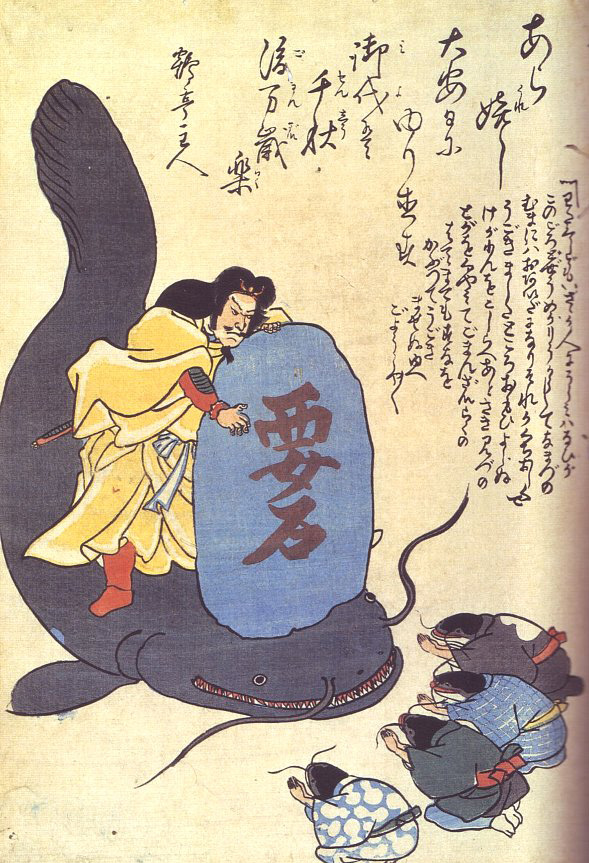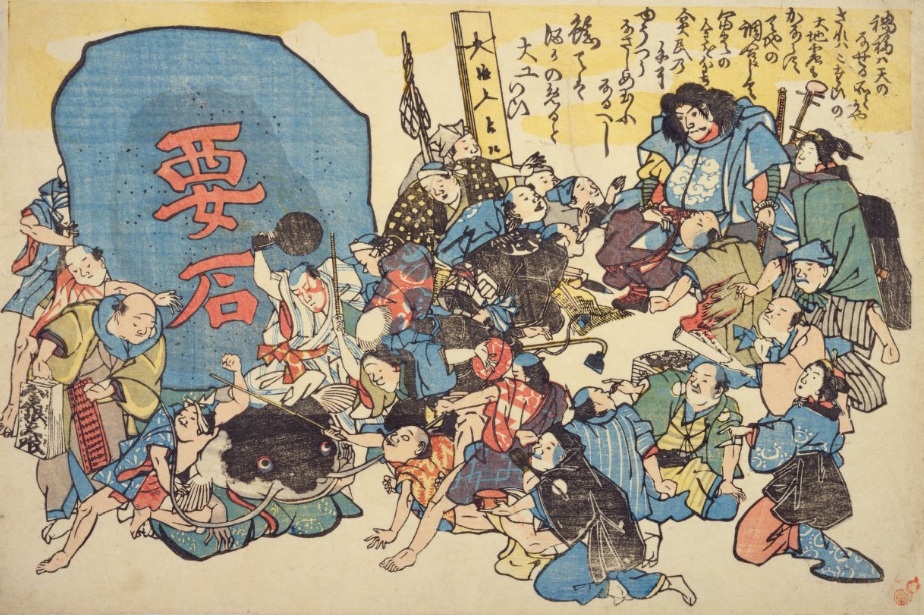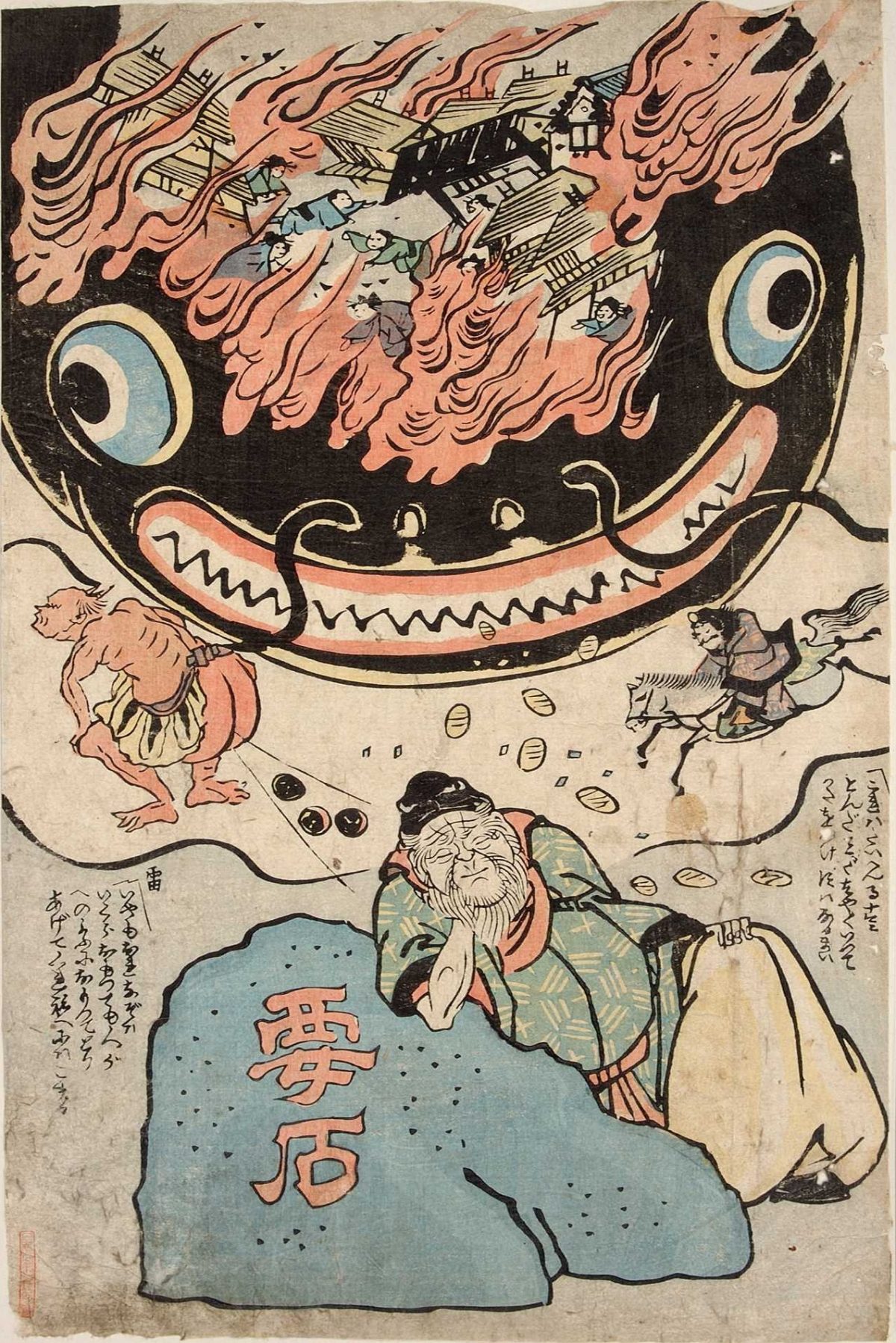
Namazu, a giant catfish, and Kashima, a god of thunder and swords, feature large in these Japanese prints from the The Edo period (江戸時代, Edo jidai) or Tokugawa period (徳川時代, Tokugawa jidai), 1603 and 1868, when Japan was under the rule of the Tokugawa shogunate and the country’s 300 regional daimyō.
Often anthropomorphic, the namazu appear on both land and sea. One huge namazu was blamed for the Great Ansei Earthquake, a 7.0 earthquake that happened below Edo (now known as Tokyo) in November, 1855. The disaster resulted in the deaths of nearly 7,000 people and the destruction of some 14,000 homes. Just two days after the event colourful ukiyo-e woodblock prints depicting giant catfish went in sale.
Even though the namazu was held responsible for the disaster, many considered it a yonaoshi daimyōjin (god of “world rectification”), an “avenger of social injustice”. The rich had hoarded their wealth. But earthquakes disturbed their treasure troves and scattered money among the people.
As many as 400 different namazu-e prints were produced before the government grew worried by their increasing satirical themes. Within two months of their creation, namazu-e were banned and the woodblocks smashed.
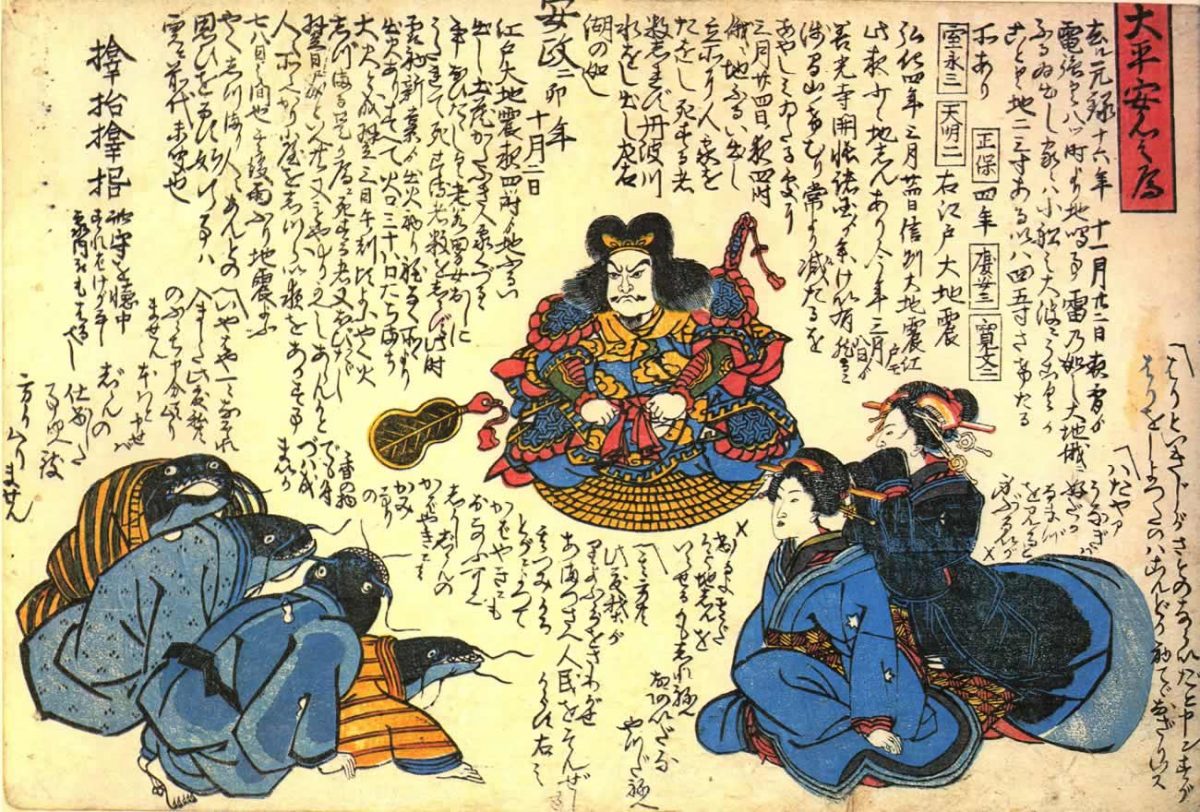
This print claims to offer protection from earthquakes. The god Kashima and prostitutes from the Yoshiwara red-light district express their anger toward the catfish responsible for earthquakes.
The Namazu Legend
Legend had it that the giant Namazu lived underground, pinned by Kashmina beneath the foundation stone (a large rock known as kaname-ishi) of a local shrine. When Kashima went away at a gathering for various gods, he left Ebisu (god of fishing and commerce) in charge. Ebisu slept on the job (see lead image above). A namazu’s frenzied thrashing triggered the earthquake.
Kashima rushed home on horseback. Raijin, the thunder god, defecated drums. Large gold coins fall from the sky, symbolizing the redistribution of wealth from the greedy to the carpenters and builders who would rebuild the destroyed infrastructure, and the prostitutes they’d pay.

A mob of earthquake victims seeks revenge on a namazu and its children.
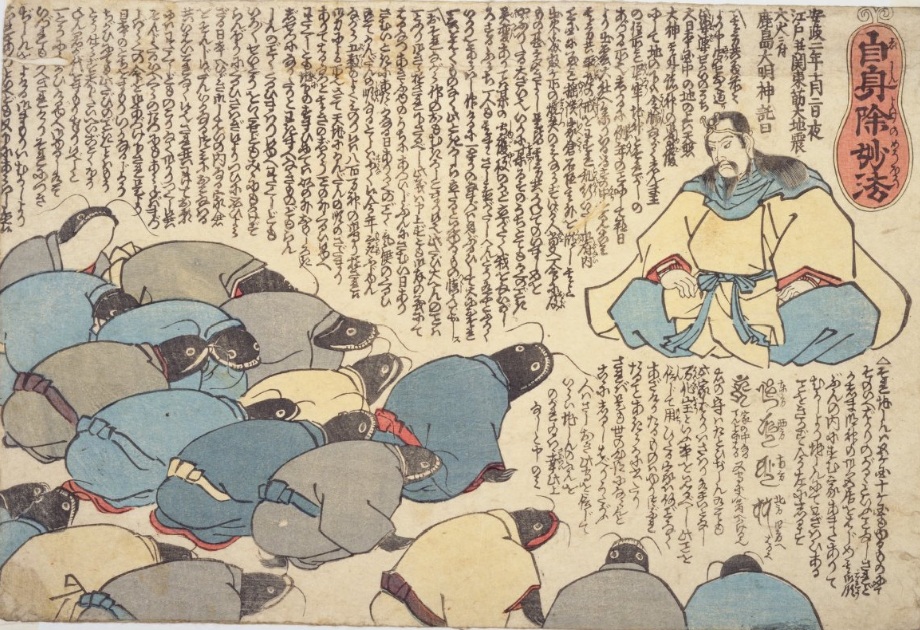
This print claims to prevent earthquake damage to one’s home if attached to the ceiling. It shows a group of remorseful catfish apologizing to the god Kashima for causing earthquakes while he was away.
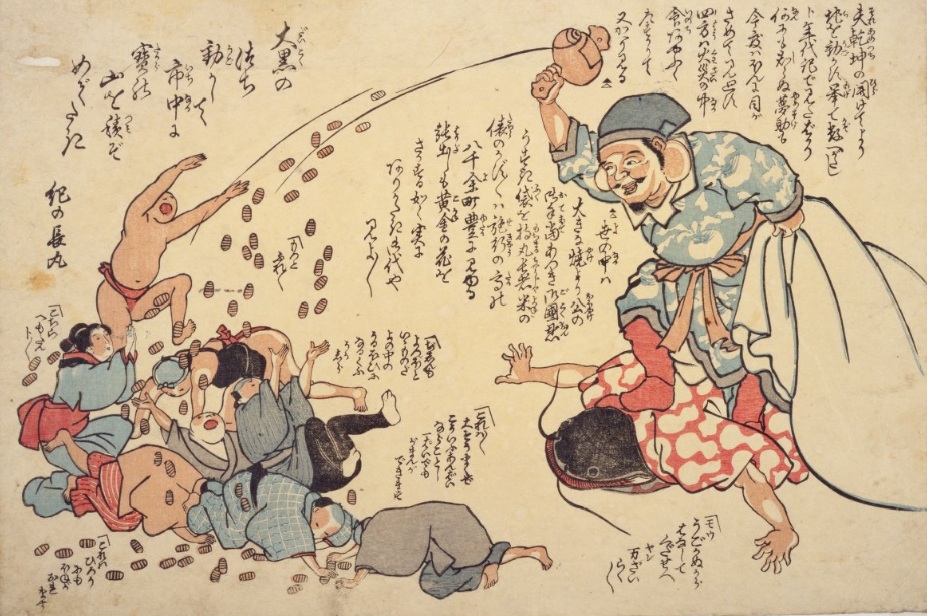
Daikoku, the popular god of wealth, restrains a namazu and showers people with money

The god Kashima is pictured in the top right corner. The kaname-ishi rock, portrayed as a person, stands on the head of the catfish, while a crowd of people try to subdue the giant beast. The people on the left who are not helping subdue the catfish include construction workers and others who typically profit from earthquakes.
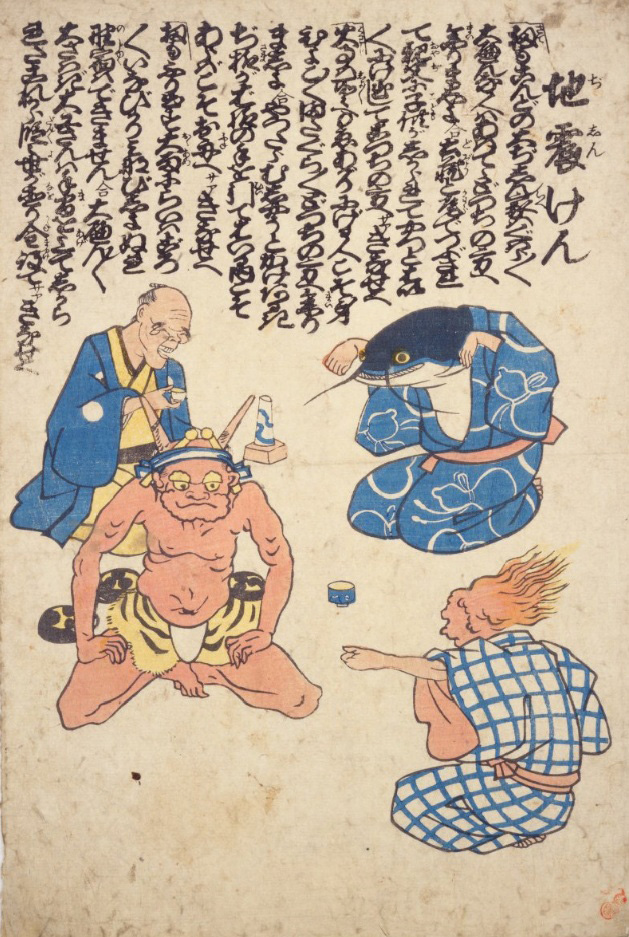
This print is a reference to the old Japanese saying, “The most frightening things are earthquakes, thunder, fires, and fathers.” Here, a namazu plays janken (paper-rock-scissors) with the gods of thunder and fire while an elderly man (father) looks on.

The god Kashima stabs a namazu. The crowd of onlookers is divided into two groups. The people in the top half of the picture are labeled as “smiling” (those who benefit from the earthquake) and the people at the bottom are labeled as “weeping” (those who are harmed by the earthquake). The top group includes a carpenter, a plasterer, a lumber salesman, a blacksmith and a roofer, as well as an elite courtesan, an ordinary prostitute, a physician, and sellers of ready-to-eat foods. The bottom group includes a teahouse proprietor, an eel seller, various entertainers such as musicians, comedians and storytellers, a seller of luxury goods, a diamond seller, and a seller of imported goods.
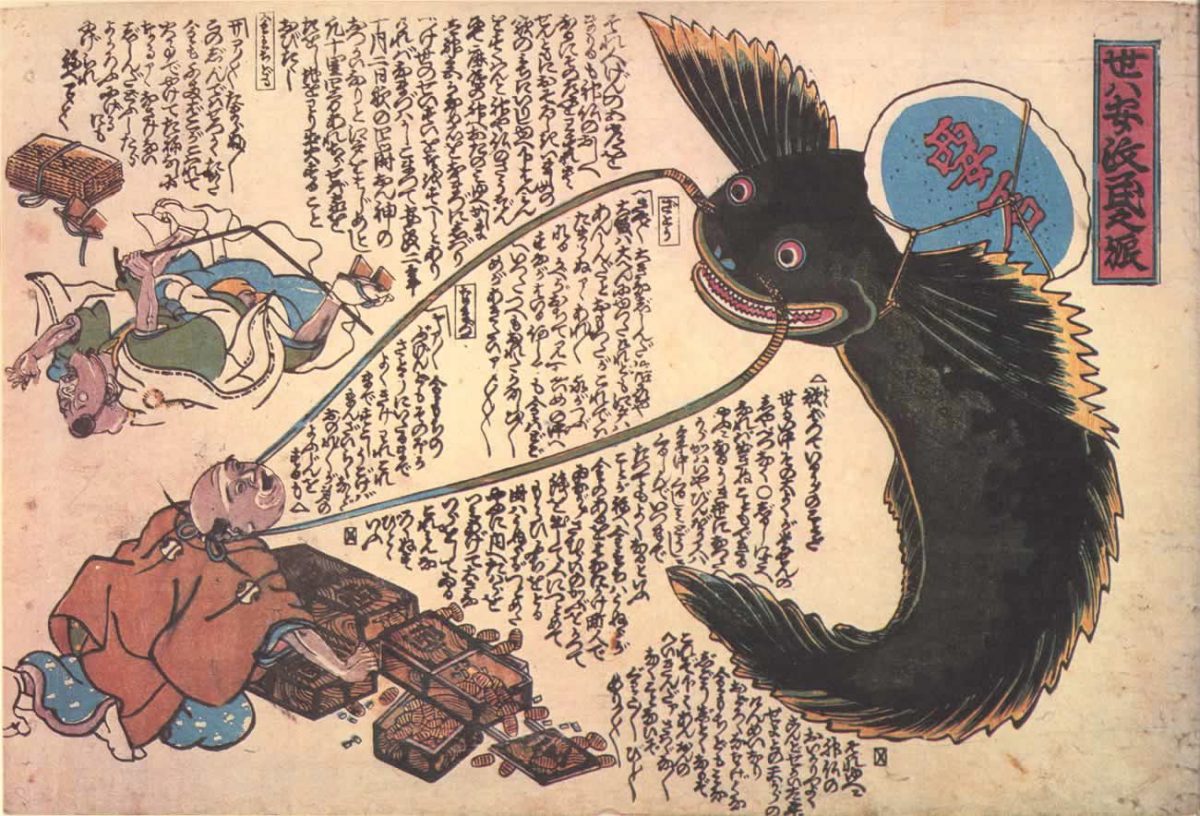
A namazu punishing a rich man and a famous actor, illustrates a popular theory that the gods deliberately allowed the earthquake to happen in order to rectify some of the imbalances in the world.
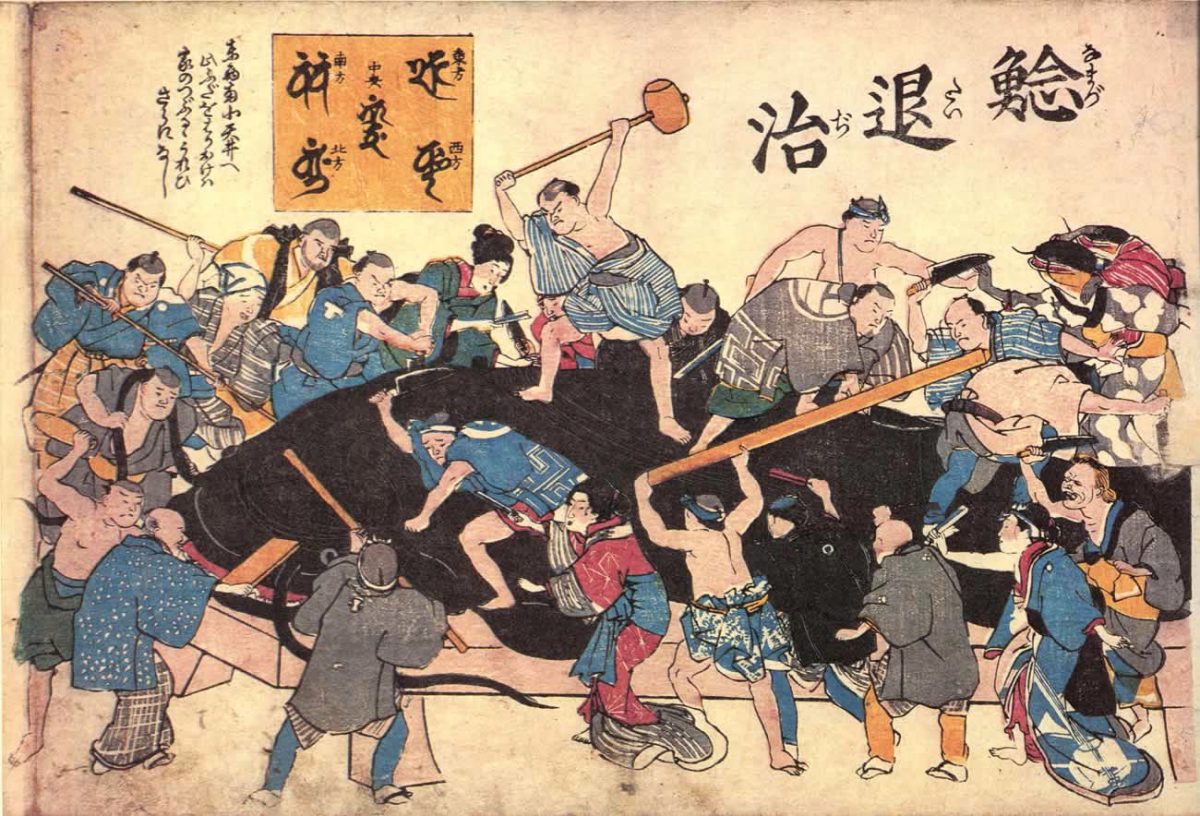
Dragons And Divine Sex
Japanese folk explanations during the late eighteenth century attributed earthquakes to such things as: 1) the movement of a giant creature (an ox, a dragon/snake, or a giant fish) supporting the earth; 2) the movement of a deity or giant supporting the earth; 3) movement or shaking of a pillar or band supporting the earth; 4) the wild sex acts of male and female deities; and 5) careless movements of human ancestors. During the seventeenth and eighteenth centuries, the notion that a giant serpentine dragon moving under the earth caused the earth to shake was especially popular. This dragon gradually transformed into a giant namazu in the popular imagination.
– Gregory Smits, Shaking Up Japan
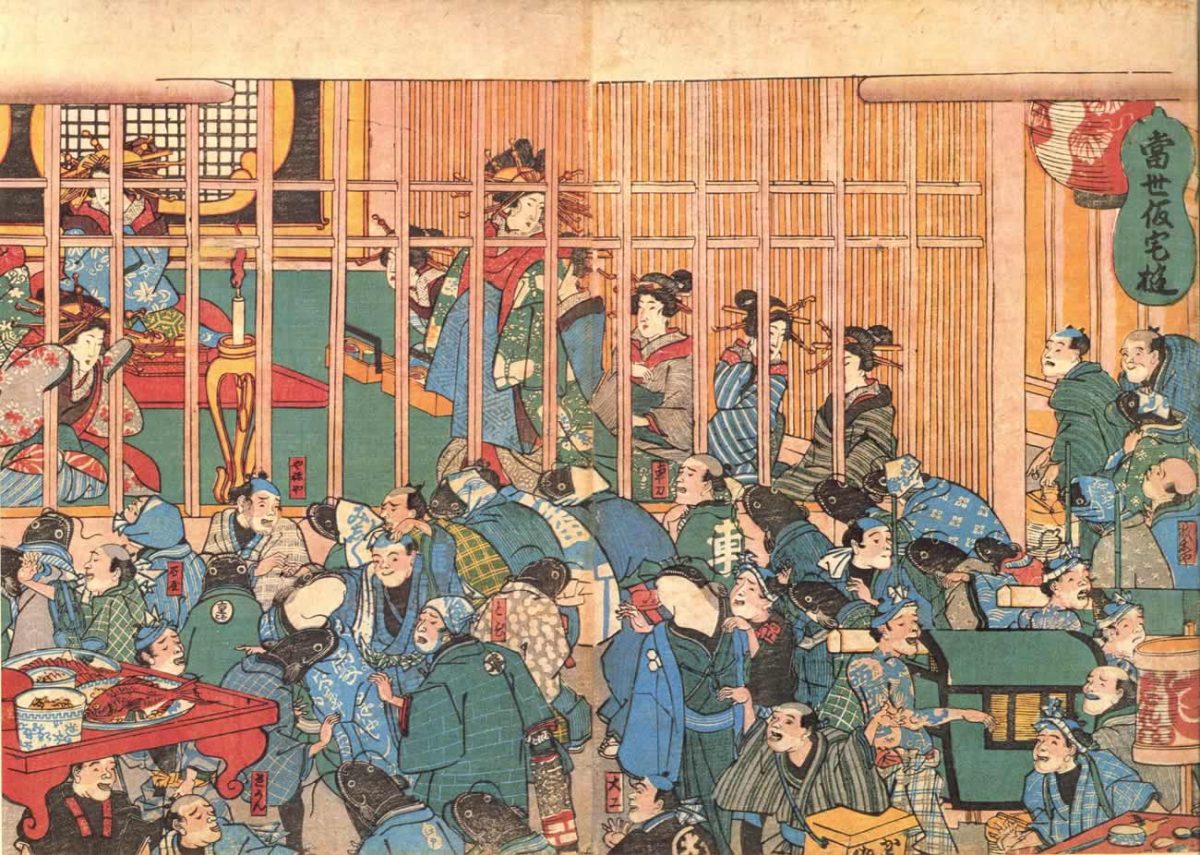
Catfish and construction workers partying in the Yoshiwara red-light district.
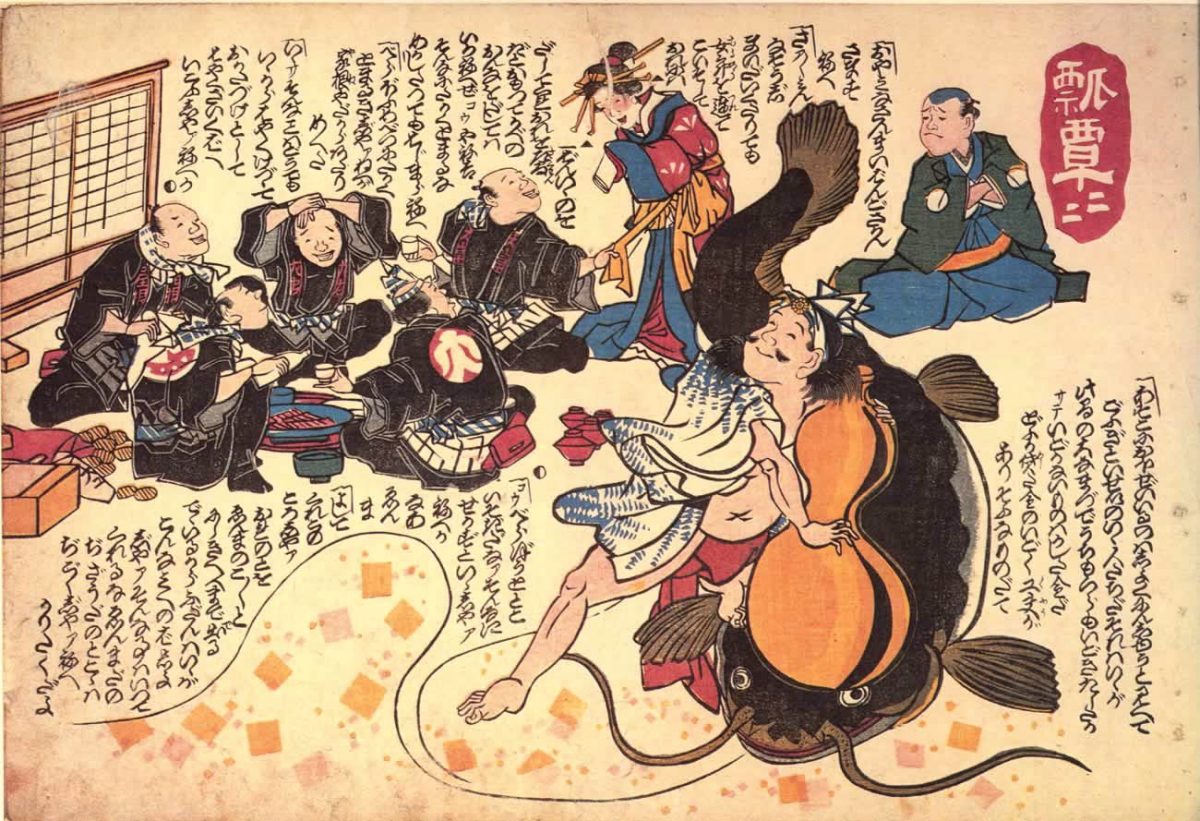
Carpenters, plasterers and roofers drinking and making merry in the Yoshiwara pleasure district while a namazu is restrained with a gourd.

Kashima using the kaname-ishi to subdue the namazu

Ridgepole raising
Mnamazu construction workers erecting the kanji character 平 (hira), which can symbolize “peace.”

A namazu tries to help a comrade escape from a trap by handing it a gourd. The image is a reference to the old Japanese expression “gourd and catfish” (meaning “slippery” or “elusive”).
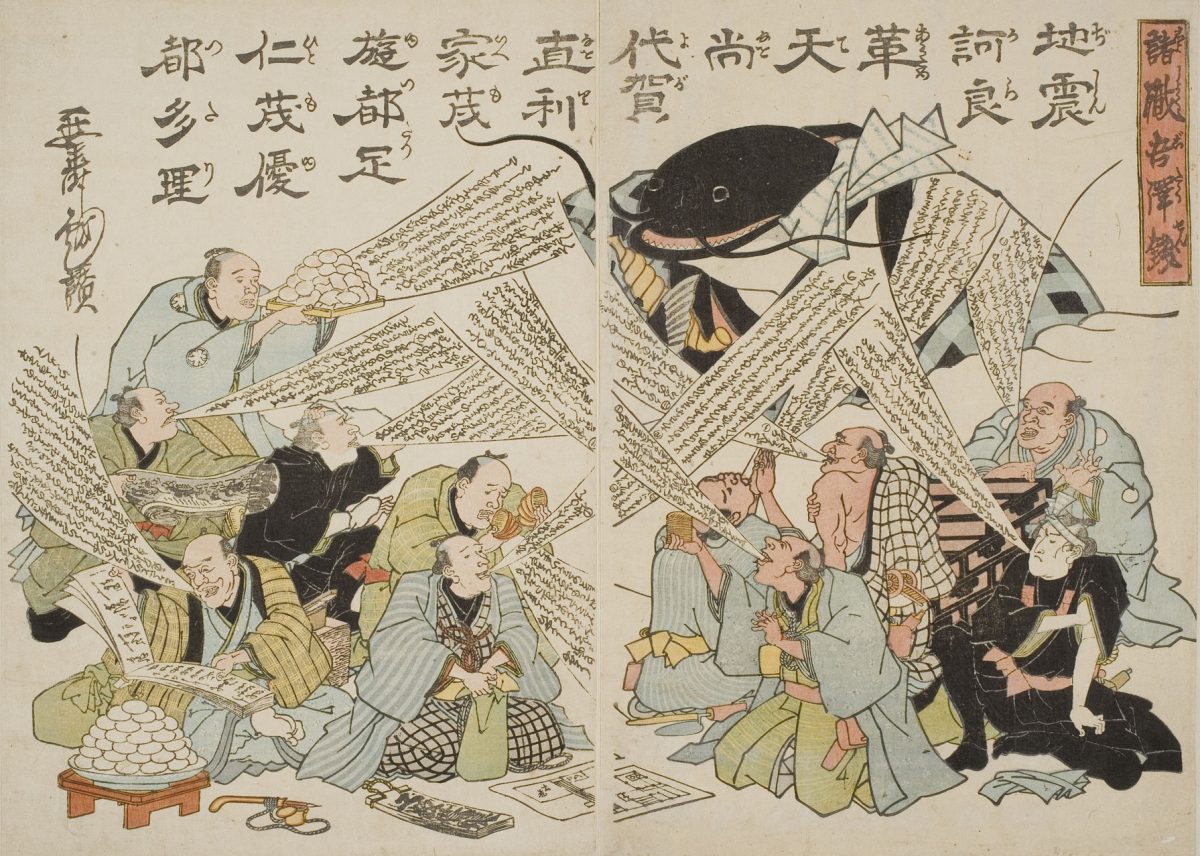
People who profit from earthquakes make offerings to a namazu
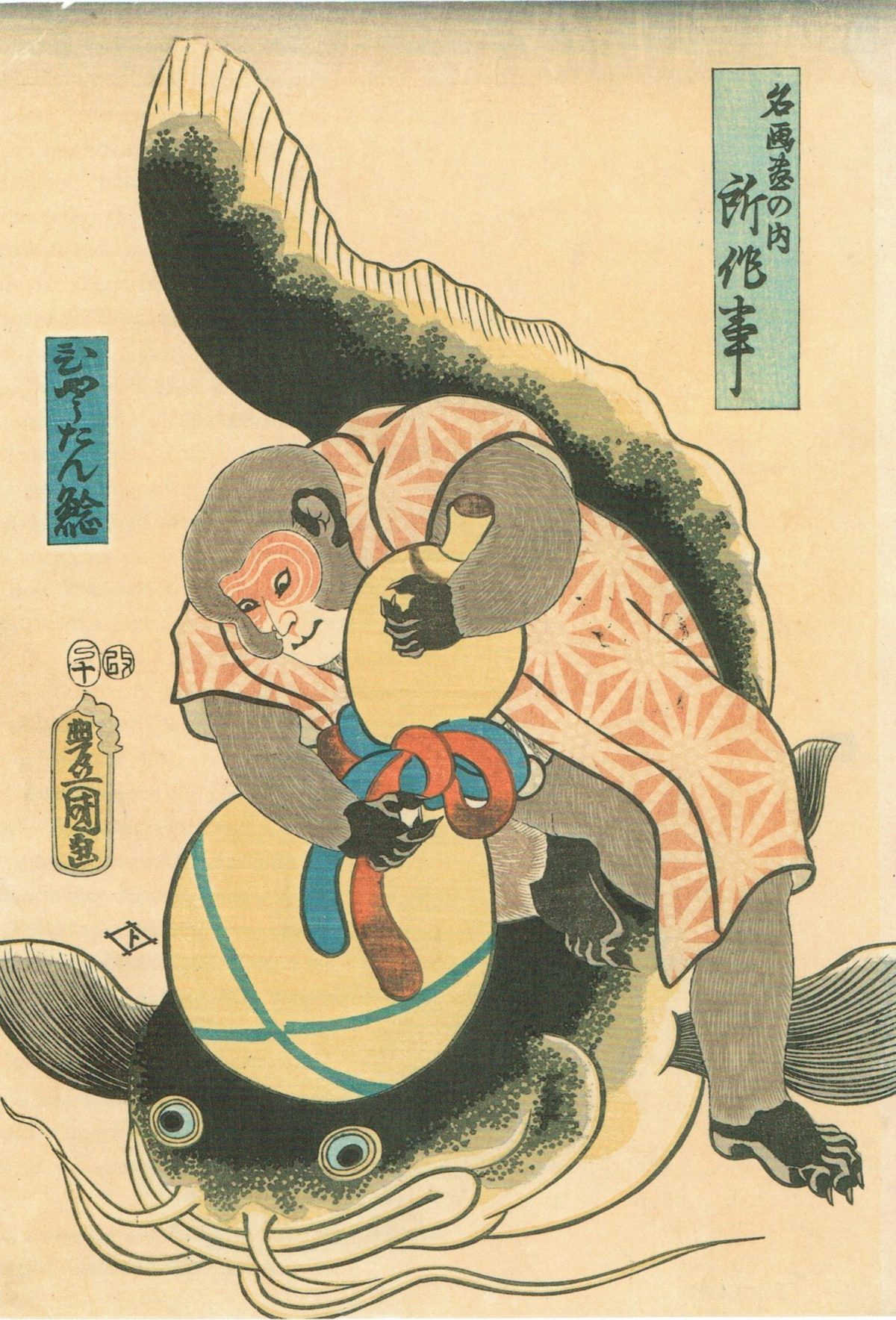
Catching a catfish with a gourd by Kunisada Utagawa


Ebisu (god of fishing and commerce) apologizes to Kashima for falling asleep on the job after drinking. The catfish leader is also apologizing, saying it was the thoughtless ones that went wild.
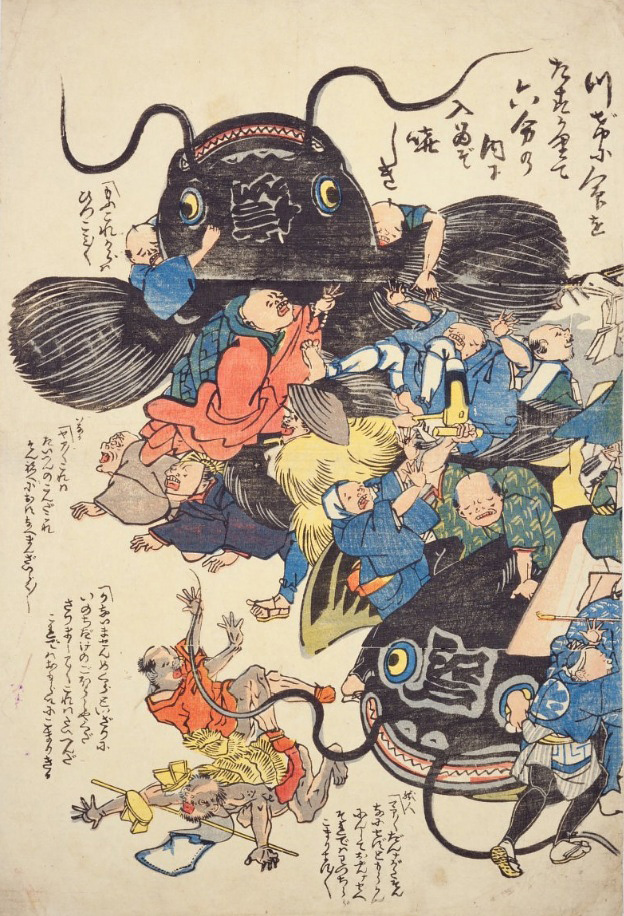
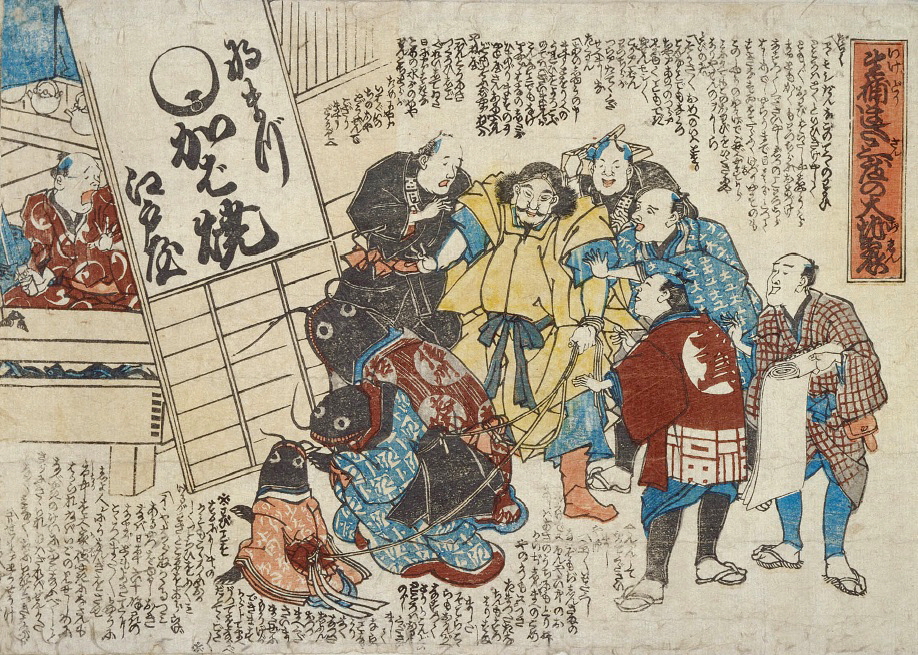
Kashima has captured the catfish responsible for the major earthquakes in Shinshu, Edo, and Odawara. A carpenter, fireman, plasterer and roofer try to persuade the god to release the catfish, saying the creatures have apologized enough. The unforgiving Kashima sentences the fish to be cooked in a nabe stew.
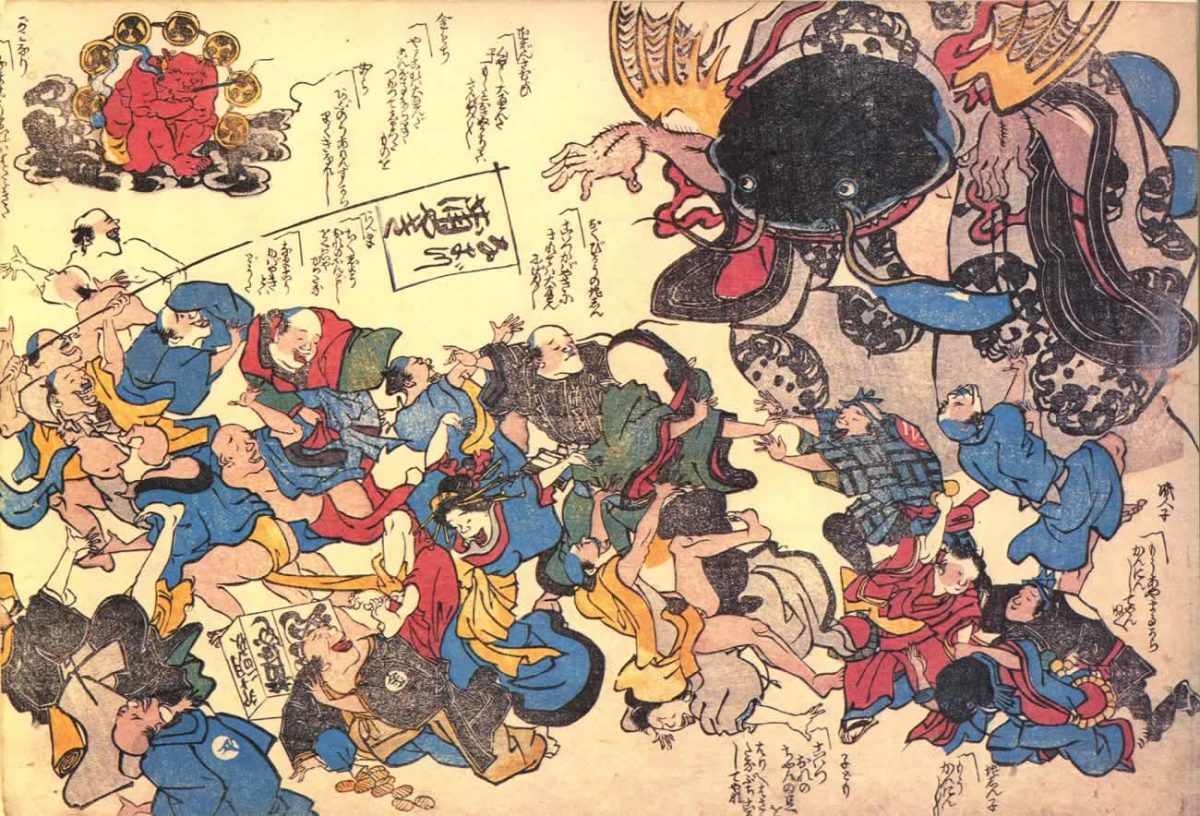
This print shows a mother namazu chasing a mob of people who have kidnapped her two children. The message on the flag carried by a person in the crowd suggests they intend to grill and eat the young catfish.
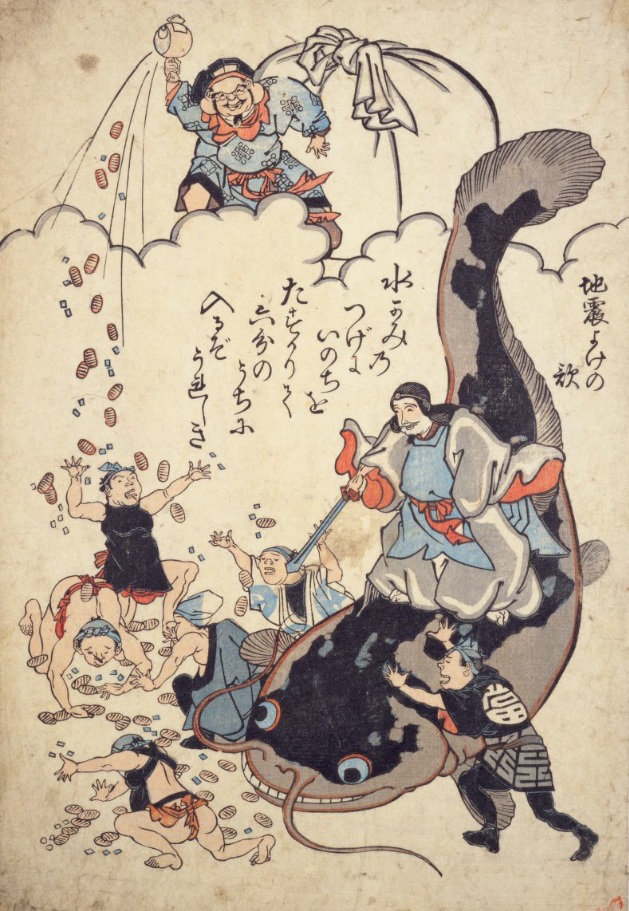
In this print, Daikoku, the popular god of wealth, showers people with money while the god Kashima restrains a namazu.

A crowd of elderly people, carpenters, young wives, china-shop owners, entertainers, Yoshiwara prostitutes, physicians, and others are offering prayers to the kaname-ishi rock, believed to have the power to keep earthquakes in check. When a person in the crowd voices his doubts about the rock’s powers, the rock responds, “I assure you that if the earth moves even a little I will stand on my head.” In the original Japanese, this answer features a pun on the words ishi-gaeshi (“overturning a rock”) and ishu-gaeshi (“taking revenge”).
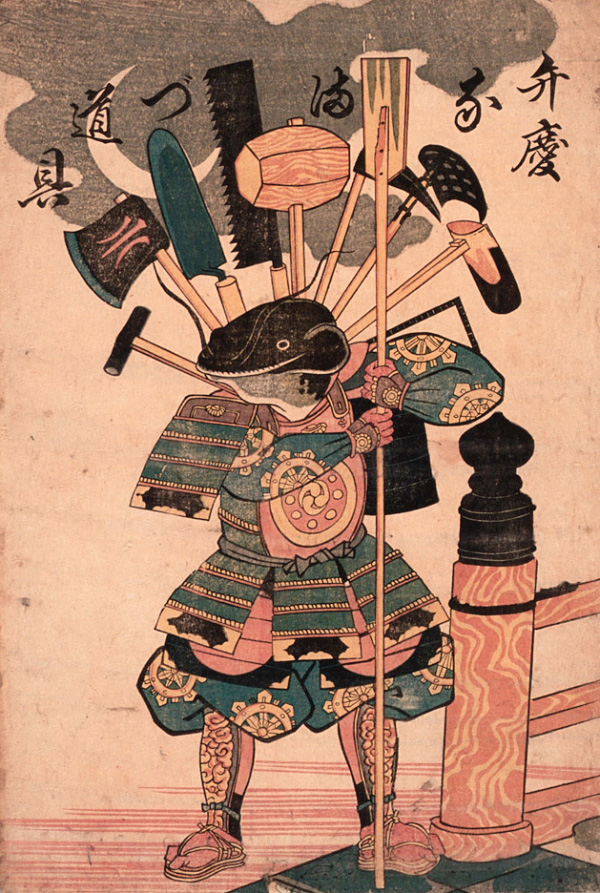
Namazu with construction tools, portrayed as the legendary warrior Benkei

This print shows people dancing around a namazu dressed as a representative of Kashima shrine in an annual ritual held before the start of the new agricultural season. The image of the rabbit represents the zodiac year of the rabbit (1855).
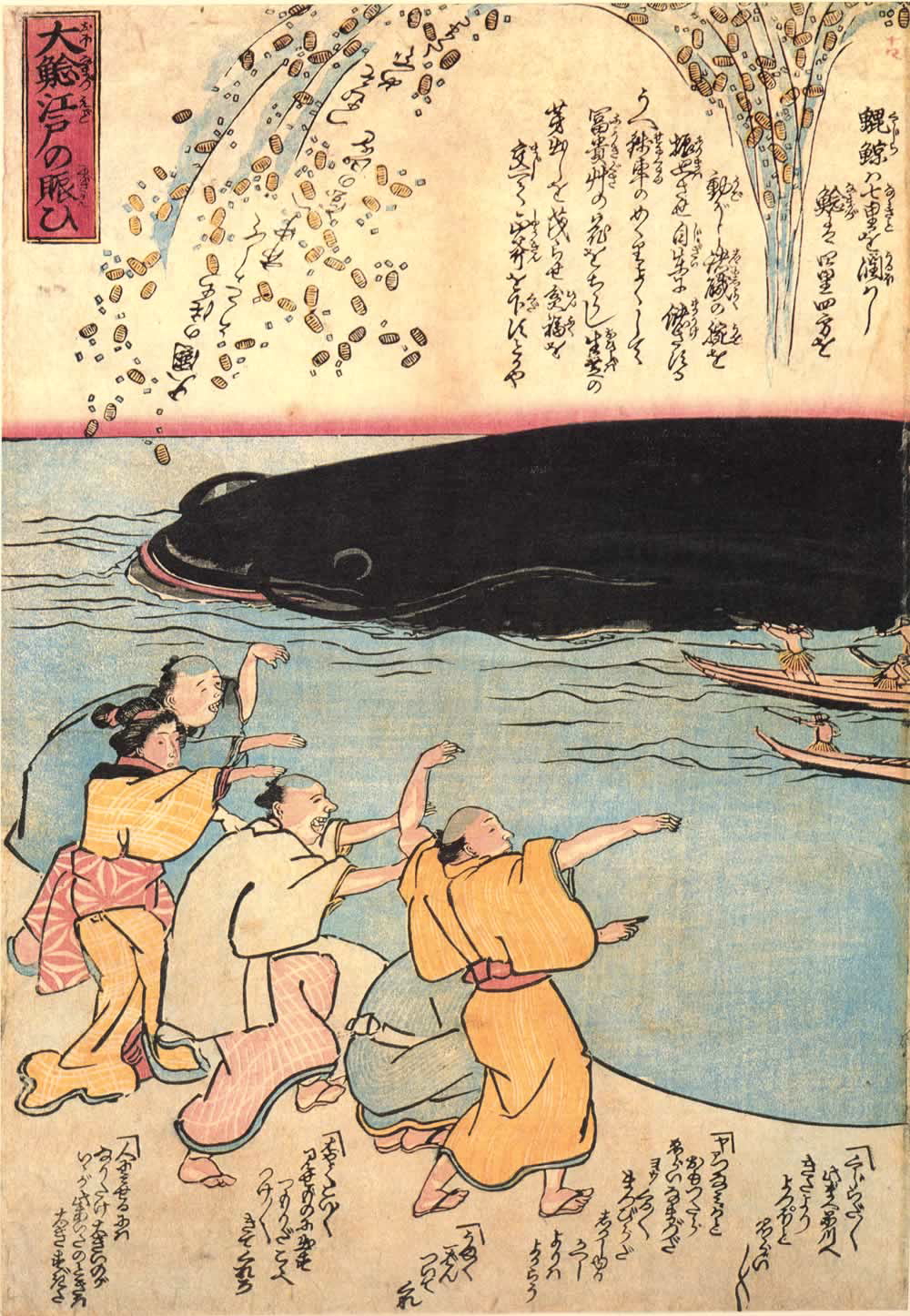
This print shows a massive steamship-like namazu approaching the city. The creature is spouting money, and people on shore beckon for it to come closer. The depiction of this namazu conjures up images of Commodore Perry’s black ships, which arrived in Japan in 1853 and eventually forced the country to open its ports to Western commerce.
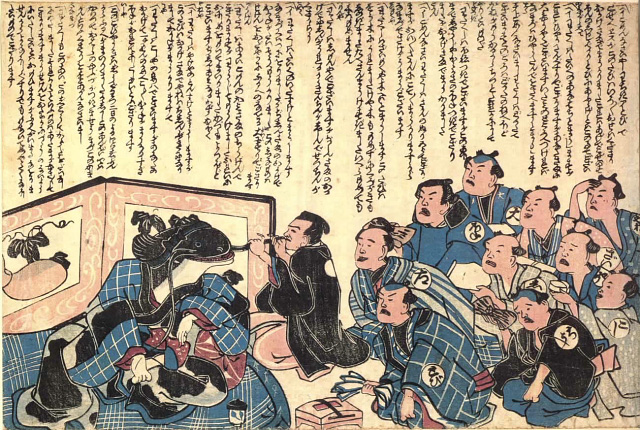
Earthquake catfish and world rectification [+]
In this print, a group of construction workers pay respect to the namazu for helping them strike it rich.

The earthquake and a “million prayers” [+]
This print depicts a namazu as a priest seated inside a giant rosary. The creature does not want to cause any more earthquakes, but the “worshipers” — tradesmen such as lumber dealers and carpenters who profit from the disaster — are praying for it to act up again. The ghosts of earthquake victims float overhead.
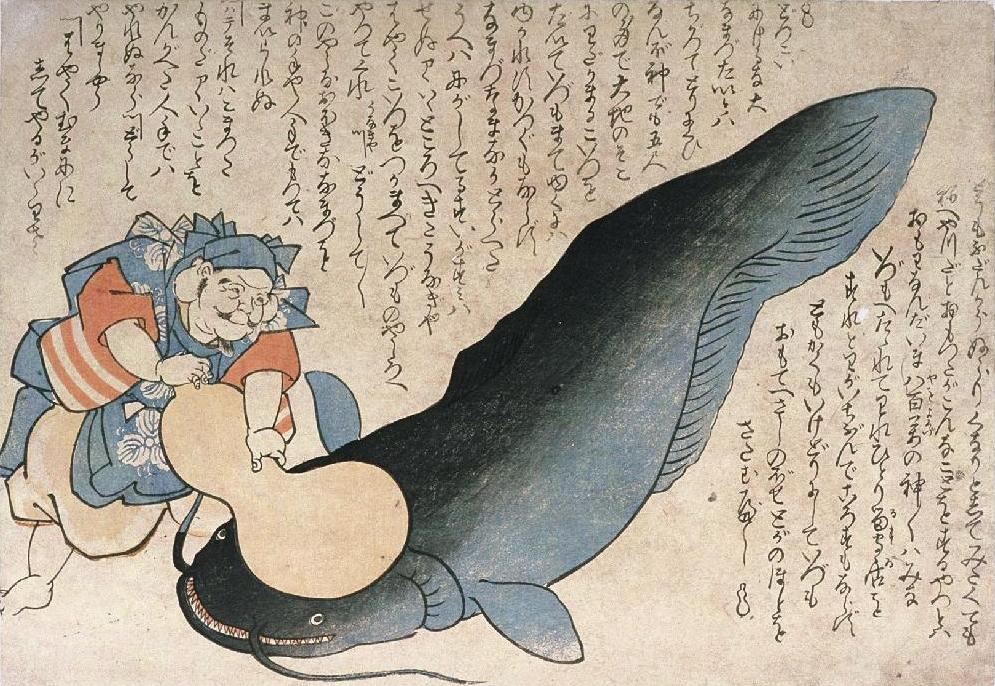
The god Ebisu restrains a giant catfish with a gourd
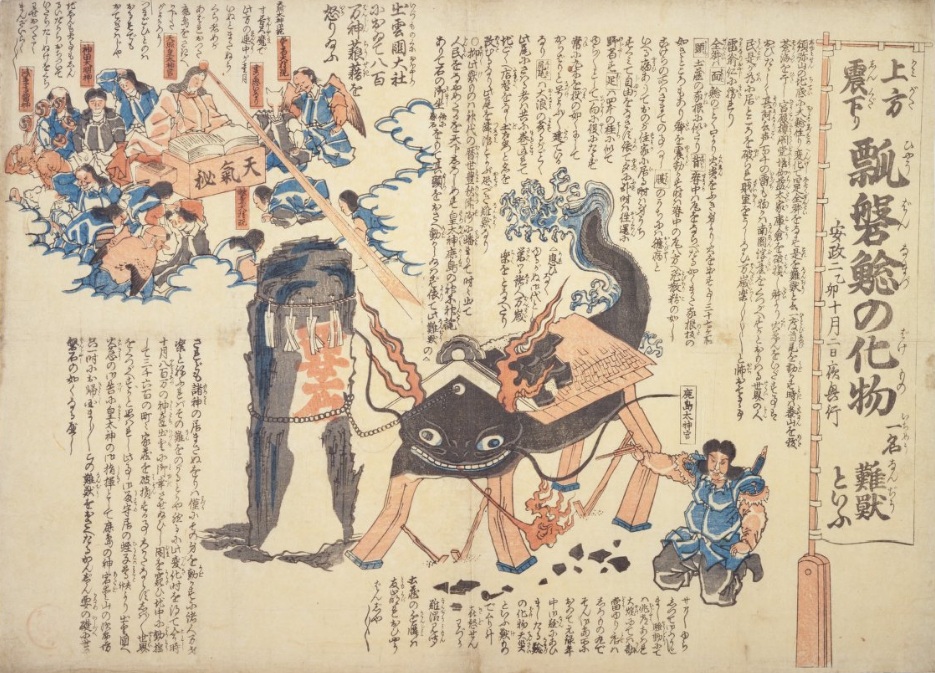


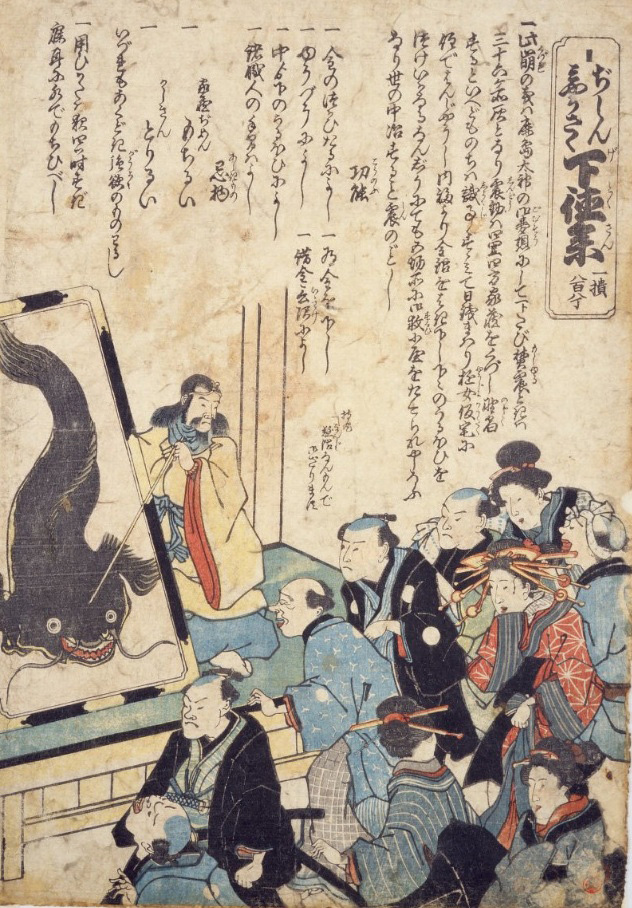

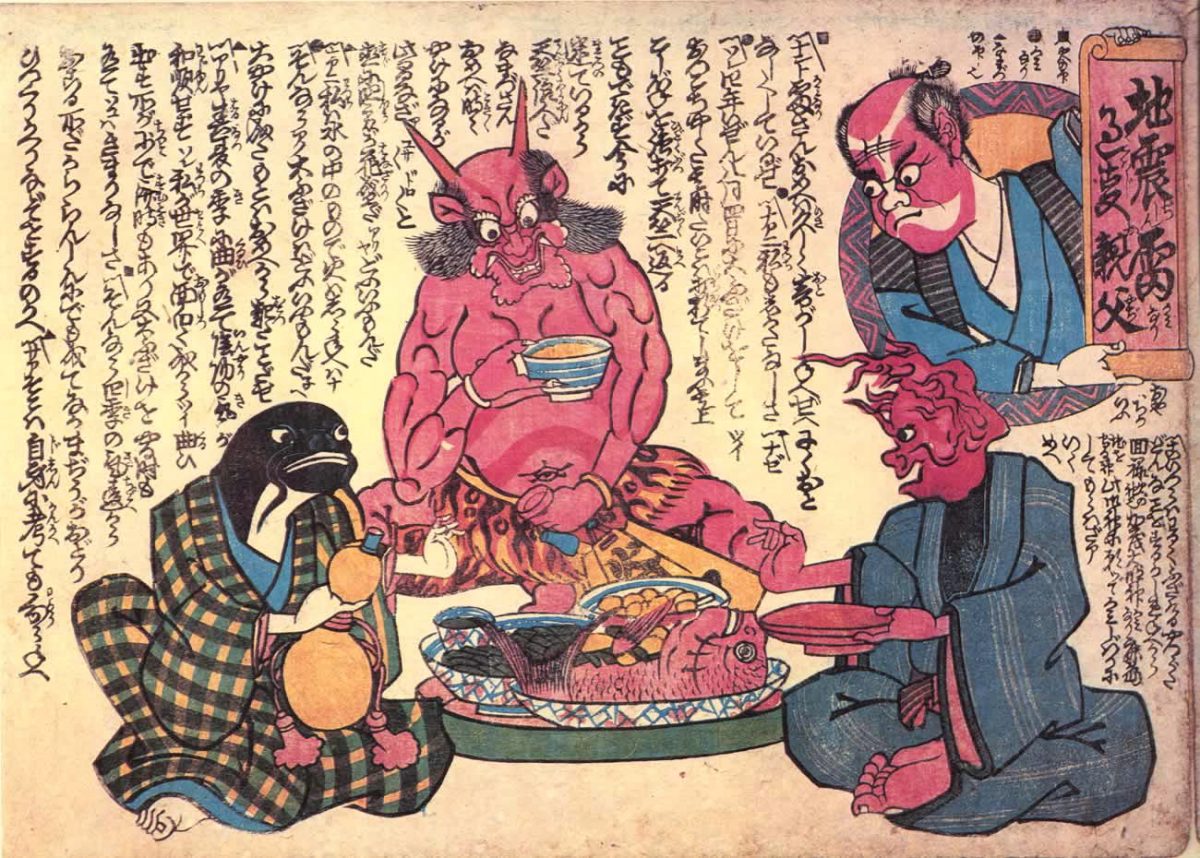

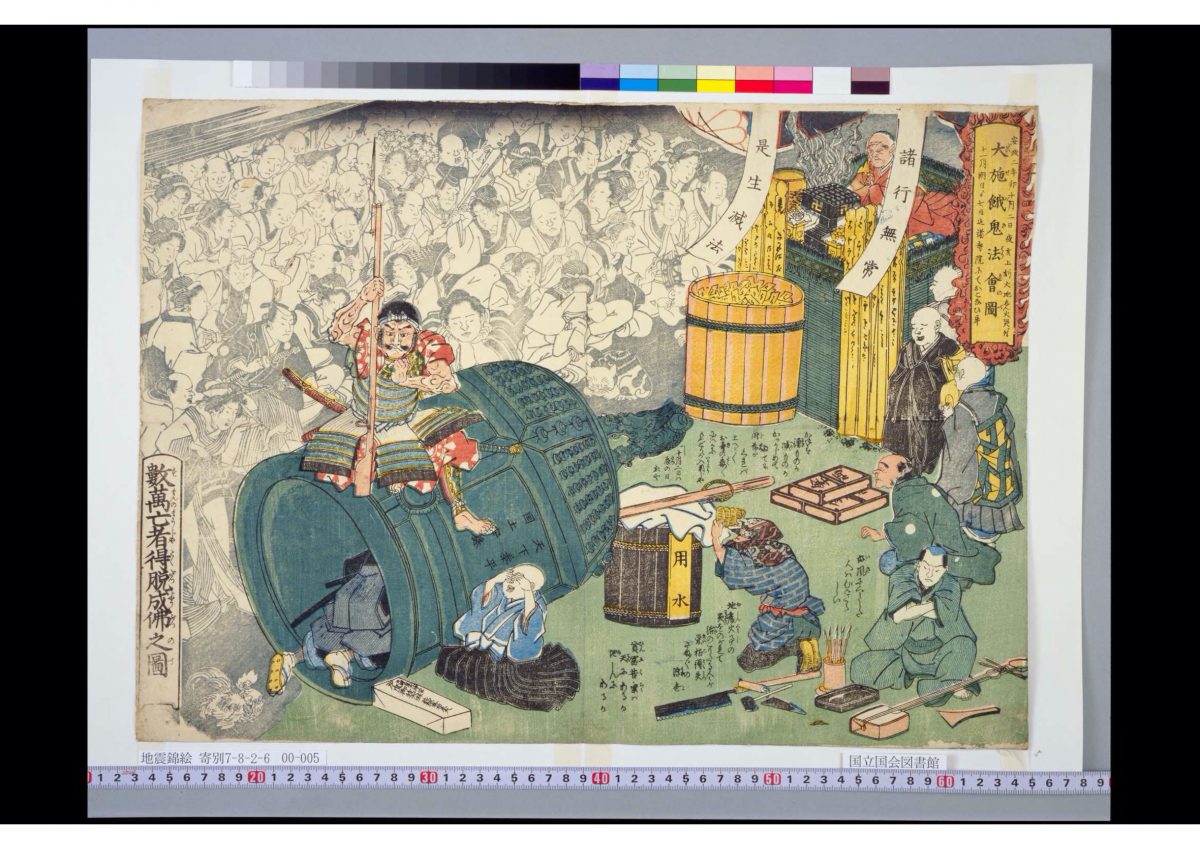

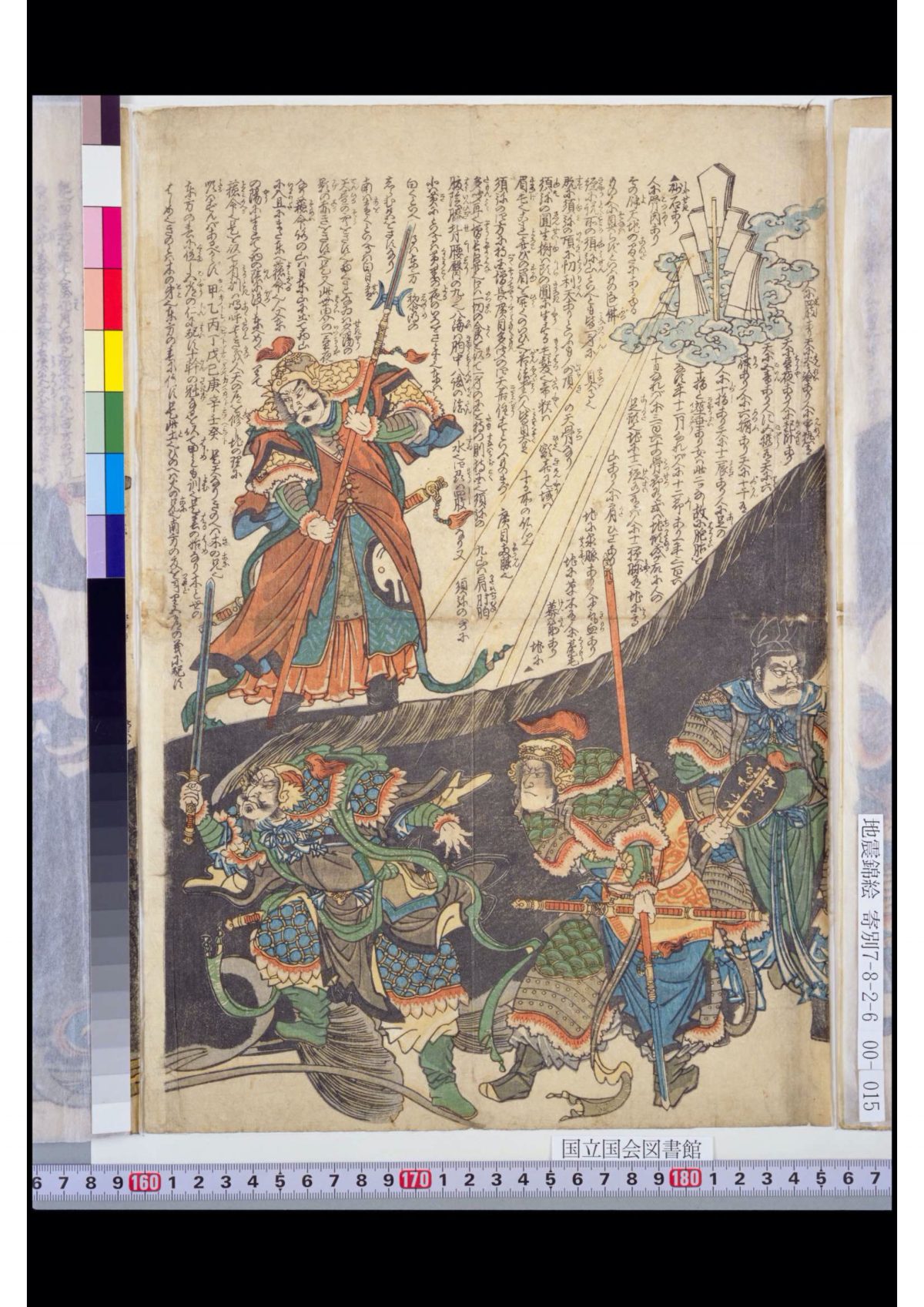

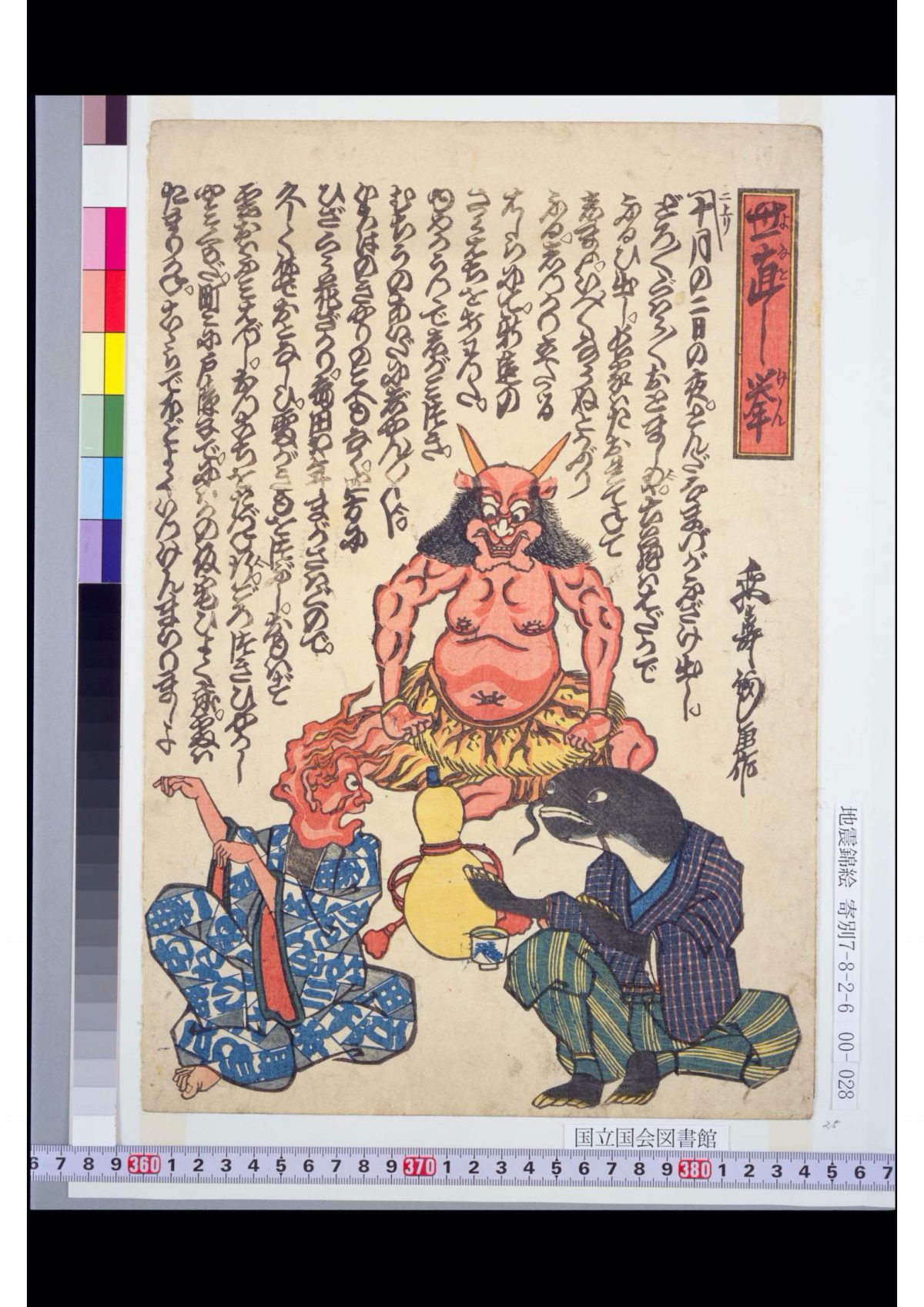


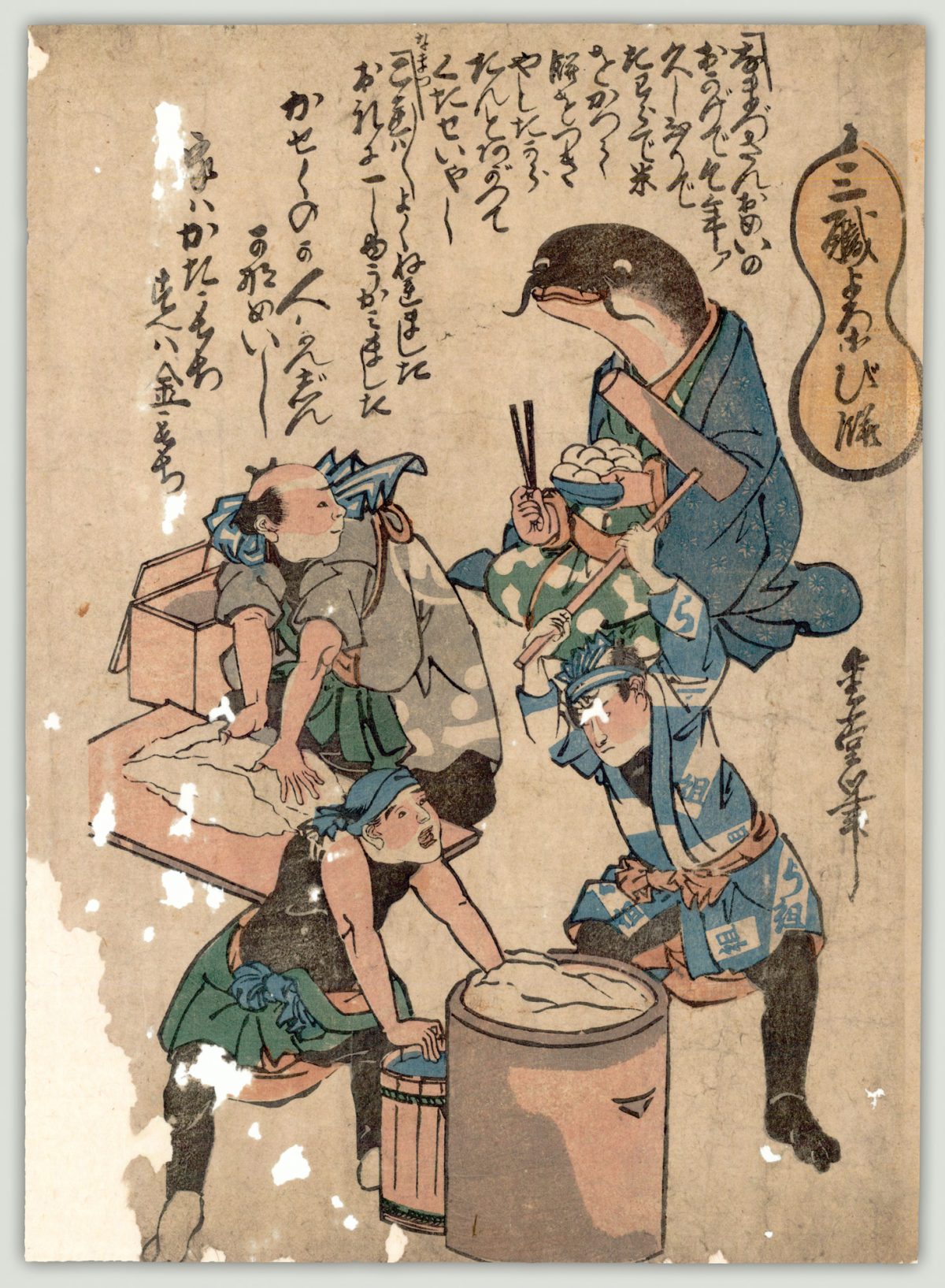

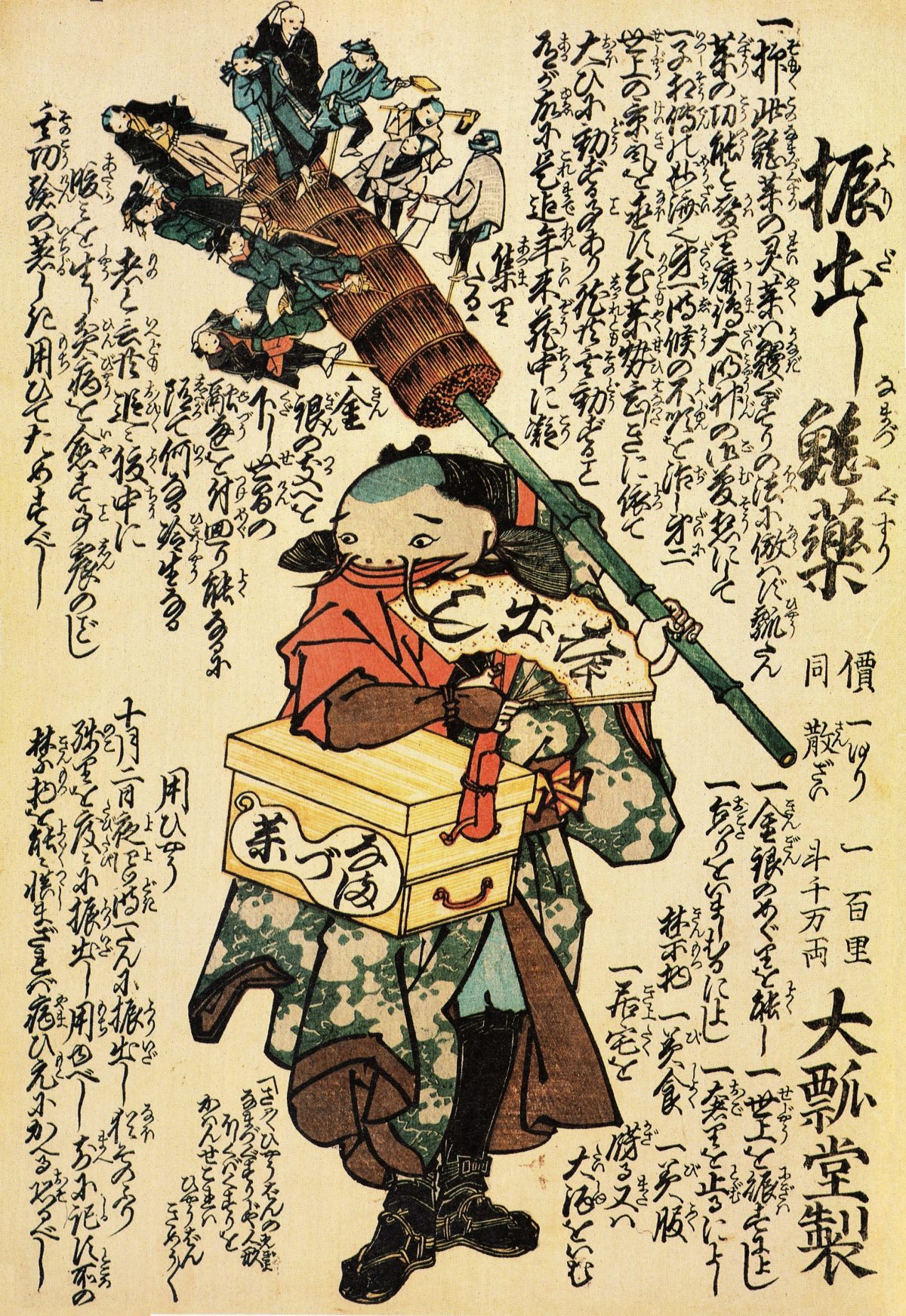
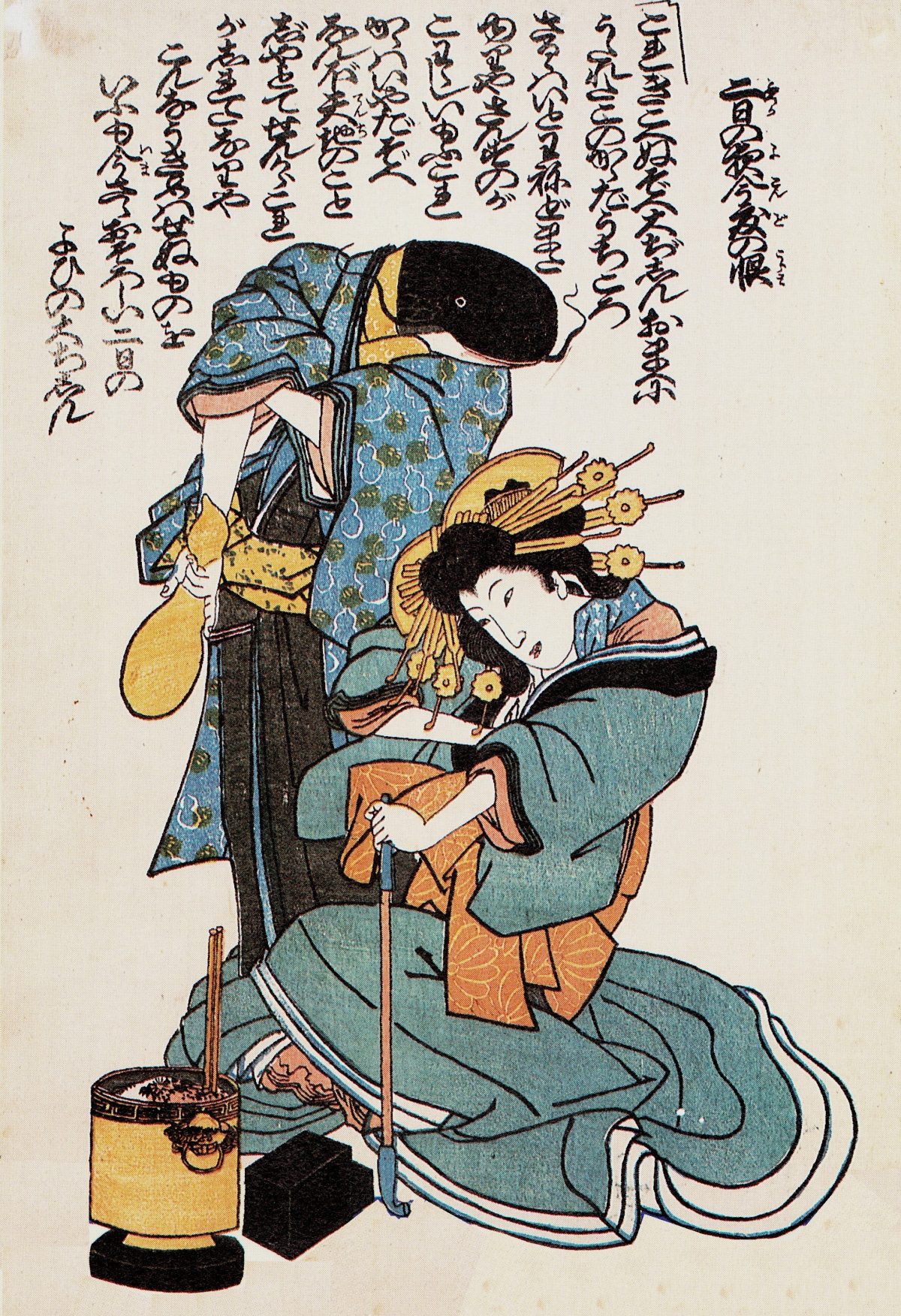
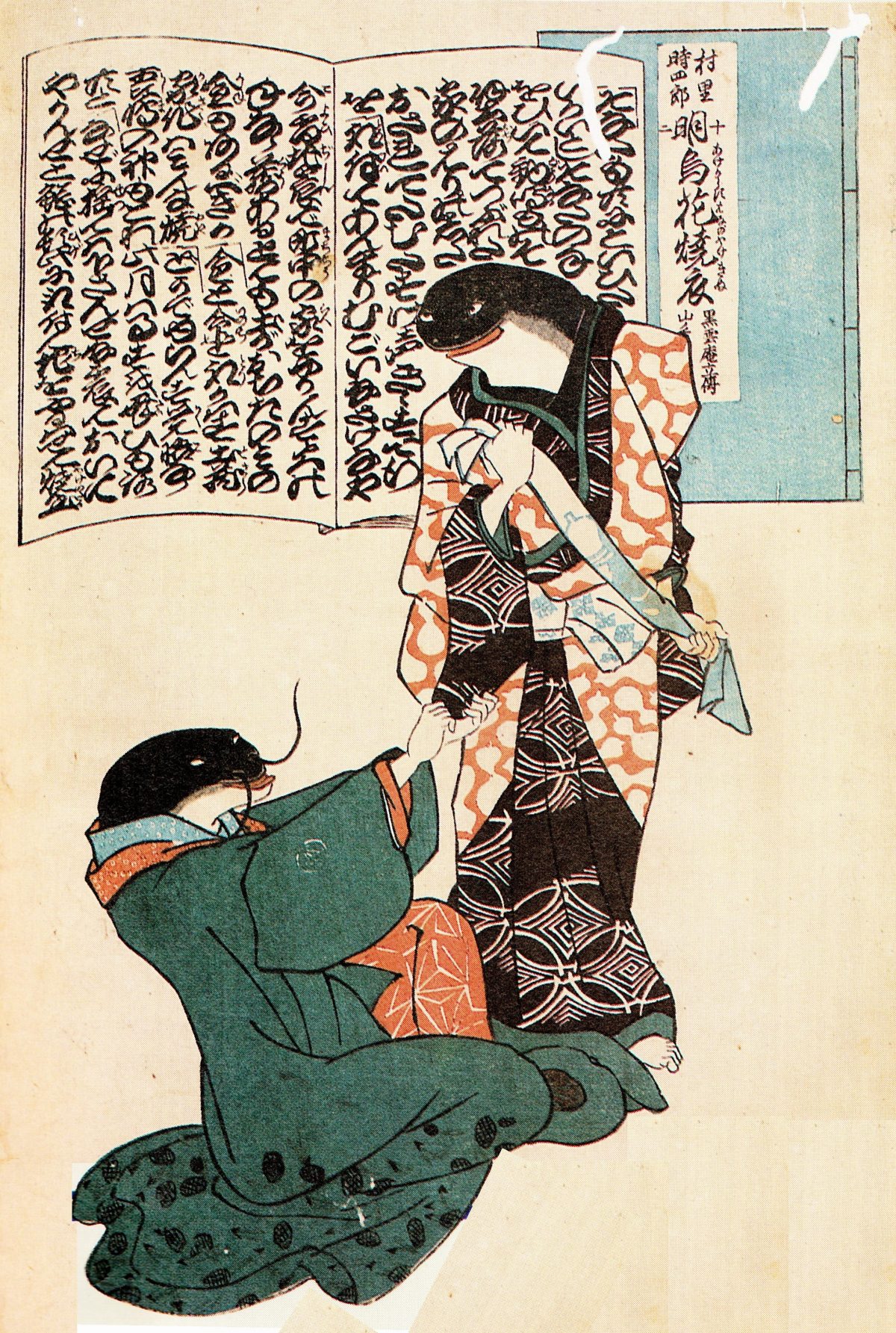
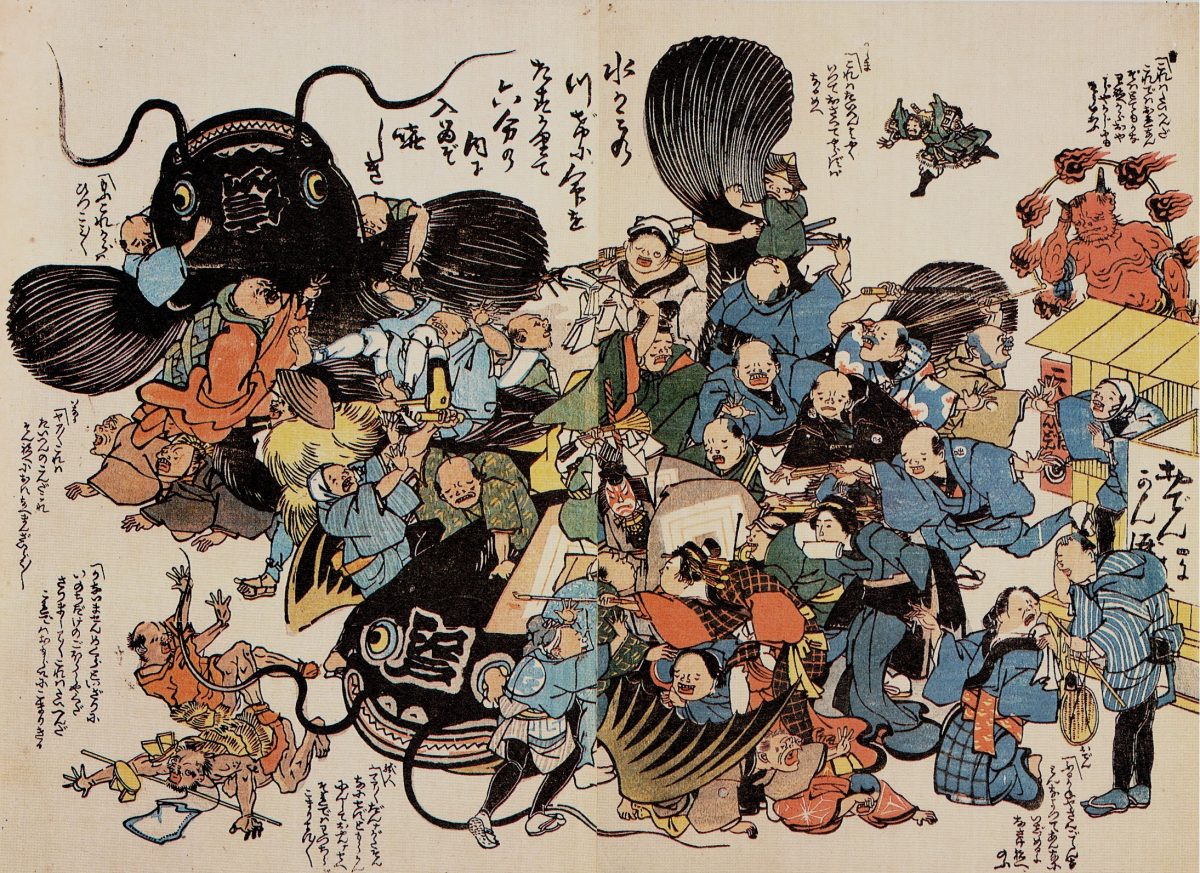
Via:More: Pink Tentacle, University of British Columbia, Disaster Prevention Museum, National Diet Library]
Would you like to support Flashbak?
Please consider making a donation to our site. We don't want to rely on ads to bring you the best of visual culture. You can also support us by signing up to our Mailing List. And you can also follow us on Facebook, Instagram and Twitter. For great art and culture delivered to your door, visit our shop.


